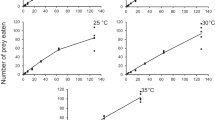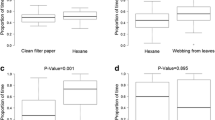Abstract
Cheiracanthium inclusum (Hentz), a hunting spider, feeds on eggs of Helicoverpa zea (Boddie) and other moths. This study investigated whether C. inclusum can use chemical compounds present in H. zea scales and egg residues as kairomones to find these non-motile prey items. In a series of no- choice tests, spiders were presented with a piece of florist paper containing scales alone, scales + egg residues, or untreated controls. Next, spiders were presented with solvent extracts of either scales or eggs. Polar and non-polar solvents were used in the extractions. Contact with scales alone, scales + egg residues, and non-polar solvent extracts of both scales and eggs resulted in retention and/or induction of local searching behavior. Extracts made with polar solvents induced no apparent response, indicating that the chemostimulatory compounds are lipophilic. These results show that C. inclusum responds to kairomones left by ovipositing H. zea and use these chemical cues to detect and locate H. zea eggs.




Similar content being viewed by others
References
Allan RA, Elgar MA, Capon RJ (1996) Exploitation of an ant chemical alarm signal by the zodariid spider Habronestes bradleyi Walckenaer. Proc Royal Soc London, Series B 263:6–73
Amalin DM, Peña JE, Duncan RE, Browning HW, and McSorley R (2002) Natural mortality factors acting on citrus leafminer, Phyllocnistis citrella, in lime orchards in south Florida. BioControl 47:327–347
Clark RJ, Jackson RR, Cutler B (2000) Chemical cues from ants influence predatory behavior in Habrocestum pulex, an ant-eating jumping spider (Araneae, Salticidae). J Arach 28:309–318
Costello MJ, Daane KM (1998) Influence of ground cover on spider populations in a table grape vineyard. Ecol Entomol 23:33–40
Cross FR, Jackson RR (2009a) Cross-modality priming of visual and olfactory selective attention by a spider that feeds indirectly on vertebrate blood. J Exp Biol 212:1869–1875
Cross FR, Jackson RR (2009b) The attentive spider: search image use by a mosquito-eating predator. Ethology 116:240–247
Cross FR, Jackson RR (2009c) Olfaction-based anthrophily in a mosquito-specialist predator. Biol Lett 7:510–512
Cross FR, Jackson RR, Pollard SD (2009) How blood-derived odor influences mate-choice decisions by a mosquito-eating predator. PNAS 106:19416–19419
Foelix RF (2011) Biology of Spiders, 3rd edn. Oxford University Press, Oxford, p 419
Fournier V, Hagler J, Daane K, Groves R, de Leon J, Costa H, and Henneberry T (2006) Monoclonal antibodies specific to glassy-winged and smoketree sharpshooter egg protein: diagnostic tools for predator gut analysis. Biological Control 37:108–118
Gazit Y, Lewis WL, Tumlinson JH (1995) Arrestment of Telenomus remus (Hymenoptera: Scelionidae) by a Kairomone Associated with Eggs of Its Host, Spodoptera frugiperda (Lepidoptera: Noctuidae). Biol Control 6:283–290
Hoefler CD, Taylor M, Jakob EM (2002) Chemosensory response to prey in Phidippus audax (Araneae, Salticidae) and Pardosa milvina (Araneae, Lycosidae). J Arach 30:155–158
Ignoffo CM (1965) The nuclear-polyhedrosis virus of Heliothis zea (Boddie) and Heliothis virescens (Fabricius). II. Biology and propagation of diet reared Heliothis. J Invert. Path 7:217–226
Institute SAS (1996) SAS system for mixed models. SAS Institute, Cary
Jackson RR, Cross FR (2011) Spider cognition. In: Herberstein ME (ed) Spider behaviour. Flexibility and versatility. Cambridge University Press, Cambridge, pp 31–48
Jackson RR, Tarsitano MS (1993) Responses of jumping spiders to motionless prey. Bull British Arach Soc 9:105–109
Jones RL, Lewis WJ, Beroza M, Bierl BA, Sparks AN (1973) Host-seeking stimulants (kairomones) for the egg parasite, Trichogramma evanescens. Environ Entomol 2:593–596
Michaud JP (2004) Natural mortality of Asian citrus psyllid (Homoptera: Psyllidae)in central Florida. Biol Control 29:260–269
Nentwig W (1986) Non-webbuilding spiders: prey specialists or generalists? Oecologia (Berlin) 69:571–576
Noldus LPJJ, van Lenteren JC (1985) Kairomones for the egg parasite Trichogramma evanescens produced by two of its hosts, Pieris brassicae L. and Pieris rapae L. J Chem Ecol 11:793–800
Nyffeler M, Breene RG, Dean DA, Sterling WL (1990) Spiders as predators of arthropod eggs. J Appl Entomol 109:490–501
Patt JM, Pfannenstiel RS (2008) Odor based recognition of nectar in cursorial spiders. Entomol Exp Appl 127:64–71
Patt JM, Pfannenstiel RS (2009) Characterization of restricted area searching behavior following consumption of prey and non-prey food in a cursorial spider (Araneae: Anyphaenidae). Entomol Exp Appl 132:13–20
Peck WB, Whitcomb WH (1970) Studies on the biology of a spider, Chiracanthium inclusum (Hentz). Bulletin of the University of Arkansas Agricultural Experimental Station. p 753
Persons MH, Rypstra AL (2000) Preference for chemical cues associated with recent prey in the wolf spider Hogna helluo (Araneae: Lycosidae). Ethology 106:27–35
Persons MH, Uetz GW (1996) Wolf spiders vary patch residence time in the presence of chemical cues from prey (Araneae, Lycosidae). J Arach 24:76–79
Pfannenstiel RS (2004) Nocturnal predation of lepidopteran eggs in south Texas cotton - 2002. In: Proc. Beltwide Cotton Conferences, National Cotton Council, Memphis TN, pp. 1594–1600
Pfannenstiel RS (2005) Nocturnal predation and their impact on lepidopteran eggs in annual crops: What we don’t see does help us! pp. 463–471. In: Proc. 2nd International Symposium on Biological Control of Arthropods. Davos, Switzerland, 12-16 Sept. 2005, USDA Forest Service, Morgantown, WV, FEHTET-2005-08, p 734
Pfannenstiel RS (2008a) Spider predators of lepidopteran eggs in south Texas field crops. Biol Control 46:202–208
Pfannenstiel RS (2008b) Development of the cursorial spider, Cheiracanthium inclusum (Araneae: Miturgidae) on eggs of Helicoverpa zea (Lepidoptera: Noctuidae). J Entomol Sci 43:418–422
Pfannenstiel RS, Yeargan K (2002) Identification and diel activity patterns of predators attacking Helicoverpa zea (Lepidoptera: Noctuidae) eggs in soybean and sweetcorn. Environ Entomol 31:232–241
Punzo F, Kukoyi O (1997) The effects of prey chemical cues on patch residence time in the wolf spider Trochosa parthenus (Chamberlin) (Lycosidae) and the lynx spider Oxyopes salticus Hentz (Oxyopidae). Bull British Arach Soc 10:323–326
Ruberson JR, Greenstone MH (1998) Predators of budworm/bollworm eggs in cotton: an immunological study. In: Proc., Beltwide Cotton Conf, National Cotton Council, Memphis, TN, pp. 1095–1098
Strand MR, Vinson SB (1982) Source and characterization of an egg recognition kairomone of Telenomus heliothidis, a parasitoid of Heliothis virescens. Physiol Entomol 7:83–90
Strand MR, Vinson SB (1983) Analysis of an egg recognition kairomone of Telenomus heliothidis (Hymenoptera: Scelionidae) isolation and host function. J Chem Ecol 9:423–432
Zar JH (1999) Biostatistical analysis, 4th edn. Prentice Hall, Upper Saddle River
Acknowledgements
We would like to thank Dr. Mamoudou Sétamou (Texas A&M University, Kingsville) for assisting us with the statistical analysis. The manuscript was greatly improved by suggestions provided by W. Meikle, T. Zaviezo and two anonymous reviewers. Funding for this project was provided by the USDA-Agricultural Research Service. Mention of trade names or commercial products in this publication is solely for the purpose of providing specific information and does not imply recommendation or endorsement by the USDA for its use.
Author information
Authors and Affiliations
Corresponding author
Rights and permissions
About this article
Cite this article
Gallagher, R.I., Patt, J.M. & Pfannenstiel, R.S. Searching Responses of a Hunting Spider to Cues Associated with Lepidopteran Eggs. J Insect Behav 26, 79–88 (2013). https://doi.org/10.1007/s10905-012-9339-3
Revised:
Accepted:
Published:
Issue Date:
DOI: https://doi.org/10.1007/s10905-012-9339-3




